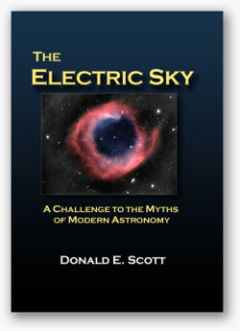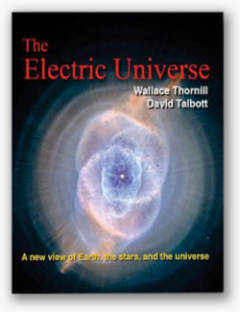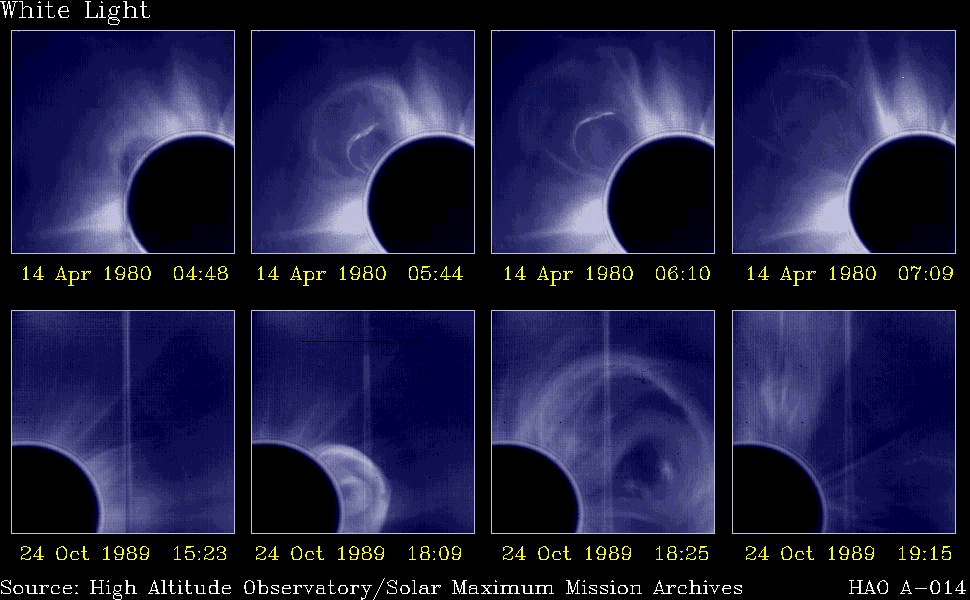Electric
Weather.
One of the more spectacular examples
of the Sun/Earth connection are the
so-called "red sprites" and "blue
jets" that have been seen shooting
into space from the tops of
thunderstorms. Sprites and jets
carry charge distribution from lower
atmospheric layers into the
ionosphere. They are usually seen at
altitudes of between 45 and 90
kilometers.
Space shuttle flights have recorded
the glow from sprites and jets as
they launched upward toward space.
They are essentially reverse
lightning bolts—beginning as
powerful upward strokes that rapidly
diminish into small filaments—and
seem to be closing the circuit
between the cloud tops and the
ionosphere.
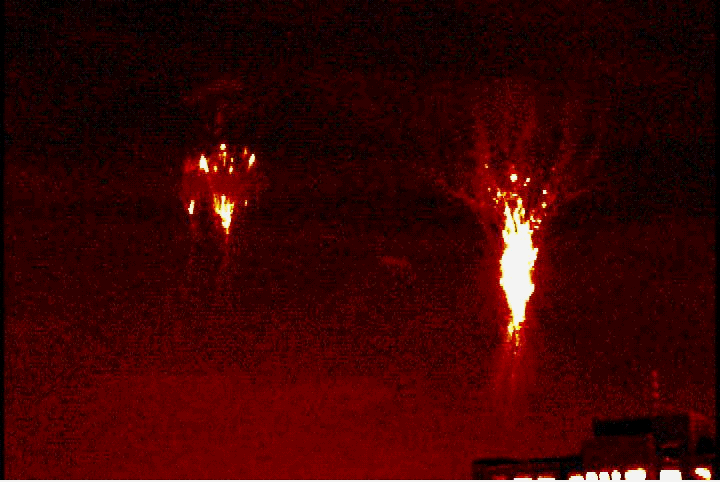
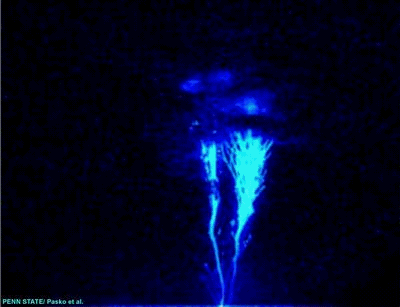
Red
sprites and blue jets. Credit:
University of Alaska, Fairbanks.
On August 25, 1997, NASA launched
the Advanced Composition Explorer
(ACE) satellite on a mission to
monitor energetic ions coming from
the Sun, as well as higher energy
particles (cosmic rays) thought to
be arriving from intergalactic
space.
ACE is in orbit around the L1
LaGrange point approximately
1,500,000 kilometers from Earth and
will remain there until 2024. Data
from the spacecraft's onboard
sensors will provide important
information that should help to
understand how the solar magnetic
field moderates incoming high-speed
ions.
During periods of high activity,
energetic pulses on the Sun eject
charged particles in the billions of
tons. They are normally slow moving,
requiring about 24 hours to reach
Earth. Known as Coronal Mass
Ejections (CME), an indication of
their arrival is an intensification
of the aurorae.
Sunlight reaches Earth in
approximately eight minutes. A solar
ejection arriving in 30 minutes must
be moving at more than a quarter of
the speed of light. In the consensus
view, such velocities are a profound
mystery, yet a gigantic CME was
observed on January 17, 2005, that
reached our planet in less than half
an hour. How do CMEs accelerate to
75,000 kilometers per second or
more?
An electric field emanates from the
Sun in all directions. The easiest
way for charged particles to
accelerate is within such a field.
The Sun's e-field extends for
billions of kilometers, ending at
the heliospheric boundary, which the
twin Voyager spacecraft are just now
beginning to penetrate. Electric
fields freely accelerate charged
particles, which move outward in
opposite directions, activating an
electric current that follows the
Sun's magnetic field.

Ultraviolet light image of the
Bastille Day 2000 solar flare
AR9077. Credit: NASA/TRACE
satellite.
As mentioned above, the
ionosphere is connected to the Sun
by twisting filaments of electric
current, so the lower levels of the
atmosphere must also experience the
Sun's influence because of the
additional circuit node that
connects them with the ionosphere.
Could these electric circuits
linking the atmosphere with the Sun
have anything to do with Earth's
climate in either the short or long
term?
On July 14, 2000, the Sun erupted
with a massive X-flare, or CME.
Solar flares are labeled C, M, or X:
light, medium, or powerful. AR9077
was classified as an X5 flare. Until
the September 7, 2005,
X17 flare impacted
Earth's magnetosphere, knocking out
radio transmissions and overloading
power station transformers, the
Bastille Day CME was considered one
of the most powerful ever recorded.
A veritable cosmic tornado of
positive ions poured into the
electrically charged environment of
our planet.
The Sun is in a relatively quiet
stage during this phase of sunspot
cycle 24. The Thermosphere,
Ionosphere, Mesosphere, Energetics
and Dynamics (TIMED)
satellite launched by NASA on
December 7, 2001, has revealed that
the amount of ultraviolet radiation
emitted by the Sun has significantly
decreased since the beginning of
this "solar minimum". Infrared
radiation emitted by nitric oxide
molecules in the upper atmosphere
has also declined, implying that the
upper atmosphere is cooling down.
It has long been known that
temperatures in the thermosphere are
dependent on solar radiation.
Extreme ultraviolet light is
absorbed by the residual oxygen and
becomes electrically charged, with
increasing molecular motion. Fast
molecular motion is known as heat,
so even though a household
thermometer would register
temperatures below zero in the
thermosphere, it is considered hot,
sometimes reaching over 1500º
Celsius during solar maximum.
Since there are fewer molecules
in the thermosphere, the amount of
thermal energy per cubic centimeter
is lower than it is at the
surface—there is not enough contact
between molecules to transfer heat.
The Sun's 22 year cycle has now
been shown to be linked with Earth's
climate. Although solar energy does
vary over the course of a sunspot
cycle, that variance amounts to less
than one-tenth of one percent, so
how are the increases and decreases
in cloud cover, temperature, and
thunderstorm activity explained?
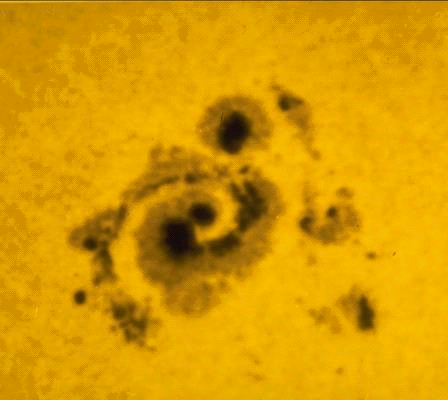
Solar flares erupt
from active sunspot regions. Credit:
Kitt Peak Vacuum Solar Telescope.
The average annual wind speed on
Earth is approximately 56 kilometers
per hour, with a maximum gust of 372
kilometer per hour recorded on Mount
Washington, New Hampshire in 1934.
Some isolated wind phenomena, such
as tornadoes and hurricanes, can
sustain average velocities of 480
and 320 kilometers per hour for
short periods.
Meteorologists are not sure how
tornadoes form, but they are often
associated with lightning storms. It
seems that the key to understanding
tornadoes is to think of them as
rapidly rotating electric
discharges. Just as copper wires
carry electrons for power
transmission, so do tornadoes. The
difference is that electrons are
moving at several centimeters per
hour in a wire, while flying around
at many meters per second in a
tornado. The result is that the
tornado forms an enormously powerful
electromagnetic force field called a
"charged sheath vortex."It is
commonly believed that weather is
driven on Earth primarily by the
Sun's thermal influence on the
atmosphere, otherwise known as
"convection." According to the
consensus theory, as Earth rotates
gases and dust absorb solar
radiation at varying rates and in
varying degrees.
When any particular region heats up,
the air expands and loses density,
creating a relative low pressure
area. Cooler air, being denser, will
naturally flow into the bottom of
the warm, low pressure region,
causing an upwardly rotating
convection cell to form.

Waterspout with lightning bolt in
the Adriatic Sea. Credit: Mladen
Duka.
Most weather systems on Earth are
thought to be based on that simple
kinetic explanation: winds blow when
the cooler, denser air flows into
the warmer, buoyant air.
The kinetic model of weather does
not take into account the fact that
planets much farther out in the
Solar System have sustained winds
that make those on our planet seem
like gentle breezes. The average
wind speeds on the gas giant planets
are fantastic.
Jupiter's winds roar at 635
kilometers per hour around the Great
Red Spot; Saturn's average wind
speed is 1800 kilometers per hour;
Uranus 900 kilometers per hour; and
Neptune comes in at 1138 kilometers
per hour. On Neptune the winds are
blowing through an atmosphere that
measures - 220 Celsius. Why is it
that the most remote planets,
receiving small fractions of the
solar energy bathing Earth, are able
to convert that small fraction into
much larger effects?
As mentioned above, Earth is a
charged body moving in a large cell
of plasma, so physical phenomena on
our planet must take the electrical
nature of plasma into account.
Perhaps lightning powers the wind?
Neptune has some of the strongest
winds of any planet in the Solar
System, yet it is farthest from the
Sun—its frigid atmosphere contradict
the thermal model of air movement.
Perhaps hurricanes, tornadoes, and
even prevailing winds are electrical
in nature?
The Electric Universe hypothesis
agrees with conventional theory that
wind is movement of air molecules,
but that there is more to the
explanation.
Electromagnetic forces in plasma
move and accelerate charged
particles, so collisions between
charged and neutral particles drag
the neutral air molecules along with
them. Close observation of
laboratory arc discharges reveals
that an electric "wind" surrounds
and often precedes an electric arc.
A plasma discharge sweeps up the
surrounding air along with the
charge carriers, or ions. The wind
appears as inflows and updrafts as
well as outflows and downdrafts. It
can lift dust particles and erode
surfaces. By analogy, we must then
question the accepted explanation of
thunderstorms as being caused solely
by convection of hot air and the
climatological movement of winds by
the Sun's heat alone.

Neptune's winds blow at 1138
kilometers per hour. Credit:
NASA/Voyager 2.
Earth is an electrically charged
body that interacts with ions
permeating space. Electricity from
space is also injected into the
thermosphere from charged particles
emitted by the Sun, speeding along
massive Birkeland currents through a
closed circuit. When solar winds are
at a minimum, the electric currents
decline in amperage, thereby
decreasing the strength of our
planet's magnetosphere.
As the magnetosphere declines in
strength, it is less able to deflect
energetic ions arriving from deep
space known as cosmic rays. Cosmic
rays are charge carriers, and those
ions are able to reach the
troposphere. Collisions between
charged and neutral particles drag
air molecules along with them,
influencing low level cloud cover.
More clouds reflect more radiation
from the Sun back to space—clouds
are white because they are acting
like mirrors to all forms of visible
light. More reflection means less
solar energy, more cloud cover, and
so on.
This leads to the more general idea
that all weather may be influenced
by the electrical connection between
Earth and solar plasma. The larger
view has only recently been
considered. Experiments designed to
verify the effect that charged
particles have on Earth's weather
are now being conducted by
scientists such as Henrik Svensmark
and Eigil Friis-Christensen of the
National Space Institute in the
Technical University of Denmark.
However, many experiments have
already falsified the mechanical
theory of atmospheric convection.
When a weather forecast is wrong it
could be considered a falsification
of the convection theory. The many
erroneous weather forecasts indicate
that some other factor (or factors)
is missing in the proposal. Electric
Universe advocates suggest that a
consideration of plasma's electrical
properties is the most important
missing factor.
Stephen Smith

